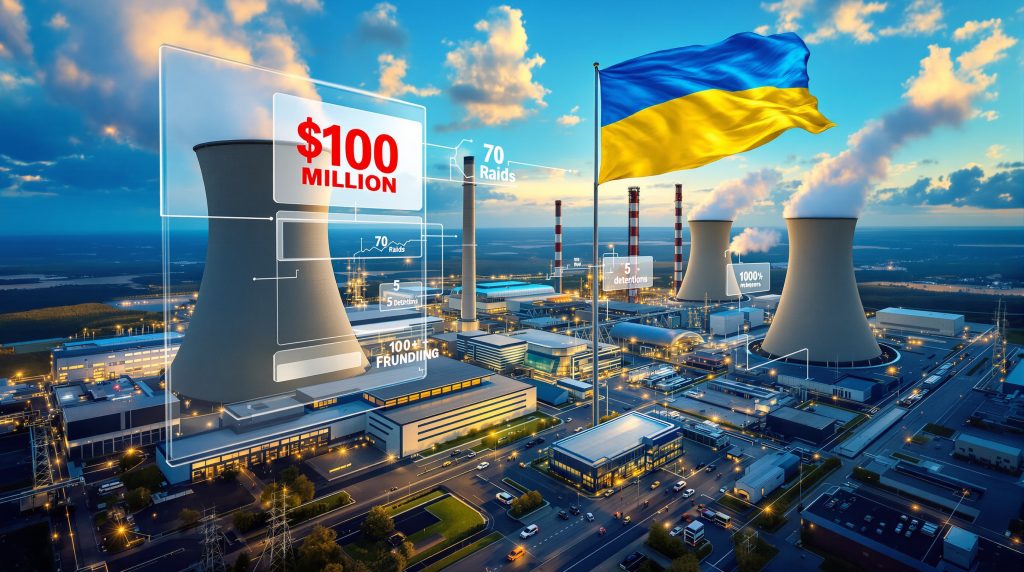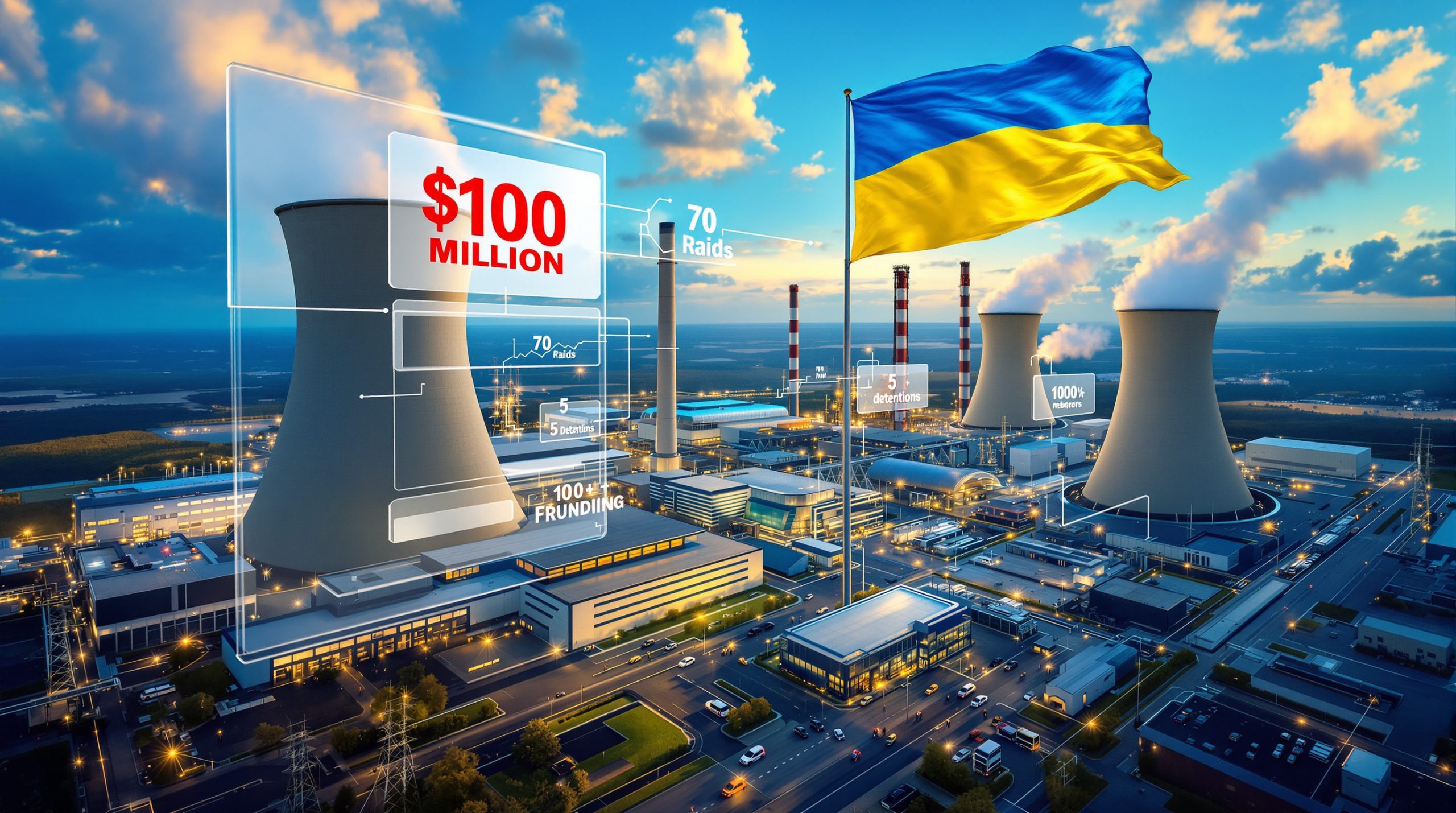Understanding the Scale of Ukraine's Energy Sector Corruption Crisis
Ukraine's energy infrastructure confronts an unprecedented dual challenge: defending against relentless Russian military attacks while simultaneously rooting out deep-seated internal corruption that threatens vital international support. The current Ukraine energy sector corruption probe represents the most comprehensive anti-corruption operation in the nation's history, targeting multiple state enterprises and high-ranking government officials across the energy sector.
This sweeping investigation has unveiled a systematic network of corruption that penetrated the highest levels of Ukraine's energy governance. The scale and scope of the probe demonstrates both the severity of the corruption problem and Ukraine's commitment to addressing it amid wartime pressures.
Key Investigation Statistics:
- Financial Impact: $100 million corruption scheme identified across multiple entities
- Investigation Duration: 15-month comprehensive probe spanning critical wartime period
- Evidence Collected: Over 1,000 hours of audio recordings documenting corrupt activities
- Search Operations: 70 simultaneous raids conducted nationwide
- Suspects Identified: 7 individuals currently under active investigation
- Detentions Made: 5 people in custody facing corruption charges
The investigation's timing during active conflict underscores the gravity of the situation. While Ukrainian forces defend critical energy infrastructure from Russian missile strikes, internal corruption was simultaneously undermining the sector's effectiveness and international credibility. Furthermore, the current crisis highlights broader energy security challenges that extend beyond Ukraine's borders.
How Does the Energoatom Kickback Scheme Actually Work?
The investigation centres on Ukraine's state nuclear power company, Energoatom, which operates the country's nuclear facilities generating approximately 50% of Ukraine's electricity. This makes Energoatom not just economically critical, but strategically vital for national security during wartime when energy independence becomes a matter of survival.
The alleged corruption network created systematic barriers for legitimate business operations while enriching a select group of officials and their associates. The scheme's sophistication suggests years of development and refinement, creating what investigators describe as an institutional culture of corruption.
The Mechanics of the Corruption Network
The Ukraine energy sector corruption probe revealed that the scheme operated through multiple strategic control points designed to extract maximum value while maintaining plausible deniability:
Procurement Manipulation:
- Contractors faced artificial delays in payment processing, creating financial pressure
- Supplier status threatened for non-compliance with unofficial kickback demands
- Personnel decisions influenced by corrupt officials rather than merit-based criteria
- Financial flows redirected through controlled channels to obscure money trails
Organisational Structure:
- High-level criminal organisation with clearly defined hierarchy and roles
- Cross-departmental coordination between ministry and enterprise levels
- Systematic documentation of corrupt activities that inadvertently created evidence
- Protected communication channels that were eventually compromised by investigators
The scheme's complexity required coordination across multiple government levels, from ministry officials who set policy to enterprise managers who controlled day-to-day operations. This vertical integration allowed the network to maintain control over both strategic decisions and operational implementation.
However, these nuclear safety challenges extend beyond corruption to encompass broader technical and regulatory concerns.
Which Government Officials Have Been Implicated in the Probe?
The Ukraine energy sector corruption probe triggered significant political upheaval, forcing multiple ministerial resignations and initiating broader parliamentary investigations. The political fallout demonstrates the investigation's credibility and the government's commitment to accountability, even during wartime.
Ministerial Resignations and Political Fallout
Energy Minister Svitlana Grynchuk:
- Resigned amid mounting pressure from investigation findings and evidence
- Previously responsible for overseeing Energoatom operations and nuclear policy
- Departure signals government commitment to accountability over political protection
- Resignation came despite wartime need for continuity in energy leadership
Justice Minister German Galushchenko:
- Also resigned following direct corruption allegations and evidence presentation
- Role in oversight of legal proceedings came under intensive scrutiny
- Resignation part of broader cabinet restructuring to restore public confidence
- Departure complicated ongoing legal reforms required for EU integration
Parliamentary Response:
- Draft dismissal bills submitted for formal legislative procedures
- Legislative pressure mounting for comprehensive sector-wide reforms
- Opposition parties demanding broader investigation scope beyond current probe
- Parliamentary committees launching parallel oversight investigations
The resignations represent more than individual accountability; they signal systemic recognition that Ukraine's international credibility depends on demonstrating genuine reform capabilities even under extreme wartime pressure. These developments highlight broader mining governance issues affecting resource-rich nations facing similar challenges.
What Role Do International Stakeholders Play in This Investigation?
The Ukraine energy sector corruption probe occurs within a complex geopolitical framework where Ukraine's international relationships directly determine its survival prospects and post-war reconstruction opportunities. International stakeholders view corruption elimination as non-negotiable for continued support.
European Union Conditions and Requirements
Integration Prerequisites:
- Corruption elimination mandatory for EU membership consideration and candidacy advancement
- Transparency standards must meet stringent European governance benchmarks
- Anti-corruption agency independence restoration required after previous setbacks
- Judicial reform implementation necessary for legal framework alignment
Financial Support Implications:
- International aid packages explicitly contingent on measurable governance improvements
- Reconstruction funding tied to accountability measures and oversight mechanisms
- Energy sector investments dependent on corruption elimination and transparency
- EU budget allocations require clean governance certification and monitoring
The European Union has made clear that Ukraine's membership aspirations depend not just on territorial integrity and democratic institutions, but on demonstrable progress in corruption elimination. The energy sector, as a critical infrastructure component, faces particularly strict oversight requirements.
Impact on Western Military and Financial Support
Strategic Considerations:
- Corruption allegations potentially undermining international confidence in Ukrainian governance
- Military aid continuation requires demonstration of domestic institutional stability
- Energy infrastructure protection programmes need clean governance for effectiveness
- International donor fatigue concerns if corruption problems persist or worsen
Western allies have explicitly linked continued support levels to Ukraine's success in addressing systemic corruption. This situation exemplifies the broader geopolitical challenges affecting resource-dependent nations in unstable regions.
How Does This Investigation Compare to Previous Ukrainian Anti-Corruption Efforts?
Ukraine's anti-corruption landscape has undergone significant evolution, particularly following sustained international pressure and domestic reform movements. The current investigation represents a watershed moment in terms of scope, sophistication, and political consequences.
Historical Context and Previous Investigations
July 2024 Agency Independence Crisis:
- Government initially attempted to curtail anti-corruption agency powers and autonomy
- International criticism and domestic protests forced complete policy reversal
- Current investigation demonstrates restored agency effectiveness and political independence
- Crisis highlighted ongoing tensions between reform and traditional power structures
Comparative Scale Analysis:
| Investigation Aspect | Current Energy Probe | Previous Major Cases |
|---|---|---|
| Financial Scale | $100 million | $50-75 million typical |
| Investigation Duration | 15 months | 6-12 months average |
| Evidence Volume | 1,000+ hours audio | Document-based primarily |
| Search Operations | 70 simultaneous | 20-30 typical |
| Political Impact | Ministerial resignations | Lower-level dismissals |
| International Attention | EU/US direct involvement | Limited foreign interest |
The current probe's unprecedented scope reflects both improved investigative capabilities and increased political will to pursue high-level cases. The investigation's success during wartime conditions demonstrates institutional resilience and commitment to reform principles.
Additionally, the investigation occurs alongside Ukrainian VAT measures that further complicate the country's economic landscape during this challenging period.
What Are the Technical Challenges of Investigating Wartime Corruption?
Conducting comprehensive corruption investigations during active military conflict presents unique operational and evidentiary challenges that distinguish the current probe from peacetime anti-corruption efforts.
Operational Complexities During Conflict
Security Considerations:
- Investigation teams operating under constant potential attack threats from Russian forces
- Evidence collection complicated by ongoing infrastructure damage and security restrictions
- Witness protection in conflict zones requiring specialised security measures and protocols
- Communication security enhanced due to wartime intelligence and counterintelligence concerns
Resource Allocation Challenges:
- Anti-corruption resources competing directly with immediate defence priorities and needs
- International oversight complicated by legitimate security restrictions and access limitations
- Documentation systems frequently disrupted by military operations and infrastructure attacks
- Personnel deployments affected by military service requirements and security concerns
Evidence Preservation and Legal Procedures
Technical Methodologies:
- Digital evidence collection prioritised over traditional physical searches due to security
- Audio surveillance capabilities expanded through remote monitoring technologies and systems
- Cross-border coordination enhanced with international law enforcement agencies and partners
- Blockchain technology utilised for evidence integrity and chain-of-custody documentation
The investigation's success despite these challenges demonstrates sophisticated adaptation of anti-corruption methodologies to wartime conditions, potentially serving as a model for other conflict-affected nations pursuing governance reforms.
Which Sectors Beyond Energy Face Similar Corruption Risks?
The investigation's findings suggest corruption patterns that likely exist across multiple sectors vital to Ukraine's wartime survival and post-war reconstruction.
High-Risk Sectors Under Scrutiny
Defence Procurement:
- Military equipment purchases under increased international oversight and monitoring
- International arms deals requiring enhanced transparency measures and documentation
- Reconstruction contracts facing comprehensive audit requirements and verification processes
- Personnel vetting procedures strengthened for defence-related positions and responsibilities
Transportation Infrastructure:
- Railway system operations under active investigation for procurement irregularities
- Port authority activities monitored for customs and logistics irregularities
- Road construction projects subject to mandatory audit requirements and oversight
- Aviation sector facing enhanced scrutiny due to wartime logistics importance
Healthcare System:
- Medical supply procurement facing intensive scrutiny and verification procedures
- Hospital construction projects under comprehensive review and audit processes
- Pharmaceutical import processes monitored for pricing and quality irregularities
- Emergency medical services funding subject to enhanced transparency requirements
These sectors face similar vulnerabilities to those exposed in the energy sector: large procurement budgets, limited competition, urgent operational needs, and complex regulatory environments that can obscure corrupt practices.
What Economic Impact Does Energy Sector Corruption Have on Ukraine?
Corruption in Ukraine's energy sector creates cascading economic effects throughout the national economy, particularly devastating during wartime when energy security directly determines economic survival and military effectiveness.
Direct Financial Consequences
Revenue Loss Calculations:
- $100 million directly diverted from critical state enterprise operations
- Estimated additional $200-300 million in efficiency losses and operational disruptions
- Tax revenue reduction from artificially inflated costs and procurement manipulation
- International investment deterrence quantified at $500+ million annually due to governance concerns
Energy Security Implications:
- Maintenance and infrastructure upgrade projects delayed by resource diversion and corruption
- Emergency repair capabilities compromised by inadequate investment and poor procurement
- Grid stability threatened by substandard equipment and delayed modernisation projects
- Nuclear safety concerns arising from procurement corruption and maintenance deferrals
Long-term Economic Recovery Challenges
Reconstruction Funding Impact:
- International donors requiring comprehensive corruption-free guarantees for major funding
- Private investment deterred by persistent governance concerns and regulatory uncertainty
- Energy sector modernisation delayed by international trust deficits and oversight requirements
- Credit ratings and sovereign borrowing costs affected by governance perception issues
The investigation revealed that corruption costs extend far beyond stolen funds to include opportunity costs, efficiency losses, and reduced international confidence that compound economic damage over time.
How Effective Are Ukraine's Current Anti-Corruption Institutions?
The success of the probe provides critical insights into the capabilities, limitations, and effectiveness of Ukraine's reformed anti-corruption institutional framework during wartime conditions.
National Anti-Corruption Bureau (NABU) Performance Analysis
Institutional Capabilities:
- 15-month investigation demonstrates sustained institutional capacity and political independence
- Advanced surveillance technology utilisation shows technical sophistication and international cooperation
- Cross-agency coordination effectiveness proven through complex multi-jurisdictional operations
- Evidence compilation standards meet international prosecution requirements and benchmarks
Resource Allocation:
- Sufficient funding secured for major investigations despite competing wartime priorities
- International technical assistance successfully integrated into domestic investigative procedures
- Specialised personnel recruitment and retention maintained despite wartime challenges
- Equipment and technology upgrades continued despite economic pressures and constraints
Specialised Anti-Corruption Prosecutor's Office (SAPO) Coordination
Legal Framework Effectiveness:
- Successful evidence compilation demonstrating prosecutor-investigator coordination effectiveness
- International legal standard compliance ensuring cross-border cooperation and extradition possibilities
- Witness protection programme implementation adapted to wartime security requirements
- Asset recovery procedures enhanced through international cooperation and information sharing
The investigation's success demonstrates that Ukraine's anti-corruption institutions have achieved sufficient independence and capability to pursue high-level cases even under extreme wartime pressure, suggesting institutional resilience and genuine reform progress.
What Reforms Are Being Implemented to Prevent Future Corruption?
The investigation has catalysed comprehensive reform initiatives designed to prevent similar corruption schemes from developing while strengthening institutional transparency and accountability mechanisms.
Structural Governance Changes
Energoatom Oversight Reforms:
- Independent board appointment procedures implemented with international observer participation
- Enhanced procurement transparency requirements including public disclosure and competitive bidding
- Real-time financial monitoring systems with automated anomaly detection capabilities
- External audit mandate expansion including international audit firms and oversight bodies
Ministry-Level Changes:
- Personnel vetting procedures strengthened with background checks and conflict-of-interest screening
- Decision-making process documentation requirements ensuring accountability and transparency trails
- Conflict of interest declaration systems expanded with regular updates and verification procedures
- Regular rotation policies implemented for key positions to prevent entrenchment and corruption networks
Technology-Based Prevention Measures
Digital Transparency Initiatives:
- Blockchain-based contract tracking systems ensuring immutable transaction records and verification
- Public procurement portal enhancement providing real-time bid information and award notifications
- Automated anomaly detection algorithms monitoring financial flows and procurement patterns
- Real-time financial monitoring with artificial intelligence analysis for suspicious activity detection
These reforms represent a comprehensive approach to corruption prevention that combines technological solutions with institutional changes to create multiple layers of oversight and accountability.
What Does This Investigation Mean for Ukraine's EU Integration Timeline?
The outcome directly influences Ukraine's European integration prospects, international standing, and timeline for achieving full EU membership status.
EU Membership Prerequisite Assessment
Current Progress Evaluation:
- Anti-corruption investigation demonstrates genuine institutional commitment to European standards
- Institutional independence restoration shows reform capacity and political will under pressure
- Political accountability evidenced through ministerial resignations despite wartime leadership needs
- International cooperation proven through cross-border investigative coordination and information sharing
Remaining Challenges:
- Systematic corruption elimination required across all government sectors and levels
- Judicial system independence must be established through comprehensive legal reforms
- Administrative capacity building needs continuation with international technical assistance
- Rule of law implementation requires sustained political commitment and institutional development
International Support Implications
Financial Assistance Continuity:
- Successful prosecution essential for continued aid package approval and disbursement
- Transparency improvements required for reconstruction funding access and management
- Energy sector governance standards must meet international benchmarks for investment
- Donor confidence restoration critical for long-term development partnership sustainability
The investigation represents a critical test of Ukraine's ability to pursue European integration while maintaining wartime effectiveness, with implications extending far beyond the energy sector to encompass Ukraine's entire European future and international credibility. According to recent reports on Ukraine's ongoing corruption challenges, the scope of these issues continues to affect multiple government levels.
Furthermore, the international community's response has been swift and comprehensive. As detailed in coverage of Zelensky's ministerial dismissals, the political ramifications extend throughout Ukraine's government structure and international relationships.
Disclaimer: This analysis is based on publicly available information and should not be considered as financial or investment advice. The situation in Ukraine remains fluid, and developments may change rapidly. Readers should seek current information from authoritative sources before making any decisions based on this content.
Looking for Investment Opportunities in Energy Transition Markets?
The corruption challenges in Ukraine's energy sector highlight why transparent governance matters for sustainable investment returns. Discovery Alert's proprietary Discovery IQ model identifies significant mineral discoveries across the ASX that power the global energy transition, providing real-time alerts on opportunities that could benefit from increased demand for critical minerals needed in renewable energy infrastructure. Begin your 30-day free trial today and position yourself ahead of market-moving discoveries in the clean energy supply chain.




